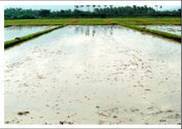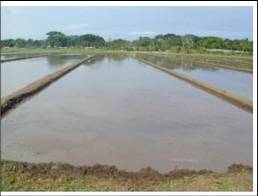|
|
|
Pest management |
|
||||||||||||||
|
|
|
|
|
||||||||||||||
|
|
|
Weed management |
|
||||||||||||||
|
|
|
|
|
||||||||||||||
|
|
|
Understand the value of integrated management in dealing with weeds |
|
||||||||||||||
|
|
|
What is the problem with weeds?
Weeds are plants that compete with the rice crop for resources. Traditionally, in the lowland systems, they have been controlled by land preparation, transplanting rice into puddled soil, flooding and water management and hand weeding. Now, as water and labor resources are becoming scarce and more expensive in Asia there is an, increased need for alternative practices. Although progress has been made in improving control methods, weed problems still represents a major challenge to improving efficiency in farm operations.
Weeds and rice
|
|
||||||||||||||
|
|
|
What can we do about the weed problem?
A common alternative practices to hand weeding is the use of herbicides. As the costs water and of labor for hand weeding increase, herbicide use accelerates.
At the same time, changes in the availability of labor and water resources are bringing about a change in the way rice is grown. Large areas are being shifted from transplanting to direct seeding, resulting in an increase in weed populations and use of herbicides.
There is evidence of herbicide-resistant weed in systems where herbicides of the same or similar type are applied repeatedly for weed control. An additional “weed” problem are the weedy rices that have infested areas in Malaysia, Vietnam, and Sri Lanka - has evolved from direct seeded rice systems.
The weed problems persist because of the farmers inability to cope with the great reproductive capacity of weeds. Further, a contributing to the weed problem is the shift in weed species composition as a consequence of the control measures applied. Because there are many kinds of weeds with varying germination periods and highly differing life cycles, management of weeds require an integrated approach based on thorough knowledge of the biology and ecology of species.
|
|
||||||||||||||
|
|
|
IPM and weeds...
Just as for insect pests of rice, a mixture of approaches for weed management needs to be applied. For more than 2000 years, water and the physical removal of weeds have been the dominant components of weed management. The changing costs of these resources demand new solutions. To date, that means herbicide application, although other approaches are being developed. Good land management with level fields (picture) can be combined with minimum water use for effective weed control; use of “clean” seed can prevent new weed species from being introduced; mechanization of planting-both for transplanting and for direct seeding-allows for easier weed management.
Improved water coverage from better land leveling reduces weeds by up to 40%
Good crop management and appropriate crop plant density encourages rapid rice canopy closure to allow the crop to better suppress weeds and , further, some rice cultivars are able to compete with weeds than others.
When should you weed?
Weed control is very important during the first 15 to 20 days after seeding or transplanting, however other weeds may compete throughout all growth stages of the rice plant. Later control may be needed to stop weeds from setting seeds but yield will already have been affected by early competition. Remember that land leveling promotes good water management and better weed control. Water is the best and most environment friendly "weedicide" in Asia. |
|
||||||||||||||
More information |
|
Click on the icon to open a manual with more information on:
Click on an icon to open a fact sheet with specific information about:
|
|
||||||||||||||
|
|
|
Visit online: http://www.knowledgebank.irri.org/IPM/weedMgmt/default.htm |
|
||||||||||||||
|
|
|
|
|
||||||||||||||
Next lesson |
|
Let's see how to deal with diseases. |
|





